contents area
Press Release
detail content area
- Date2020-03-30 20:46
- Update2020-03-30 20:46
- DivisionDivision of Risk assessment and International cooperation
- Tel043-719-7556
Updates on COVID-19 in Republic of Korea
30 March 2020
○ As of 0:00, 30 March 2020, a total of 9,661 cases (including 476 imported cases) have been confirmed, of which 5,228 cases have been discharged from isolation. Newly confirmed cases are 78 in total.
[Table 1. Total confirmed and suspected cases]
|
Period (since 3 Jan) |
Total |
Tested positive |
Being tested |
Tested negative |
|||
|
Confirmed |
Discharged |
Isolated |
Deceased |
||||
|
As of 0:00 29 March (Sun) |
394,141 |
9,583 |
5,033 |
4,398 |
152 |
15,028 |
369,530 |
|
As of 0:00 30 March (Mon) |
395,194 |
9,661 |
5,228 |
4,275 |
158 |
13,531 |
372,002 |
|
Difference |
1,053 |
78 |
195 |
-123 |
6 |
-1,497 |
2,472 |
○ Epidemiological links have been found for 84.1% of the total cases; 11.0% are either under investigation or sporadic cases. More details on the epidemiological links within each province or city are shown in Table 2.
○ From Manmin Central Church in Guro-gu, Seoul, 10 additional cases were confirmed. The current total is 23 confirmed cases (church members = 19; family members and other contacts = 4) since 25 March. Two (2) of the confirmed cases reported yesterday have been found to have worked in a call center in Geumcheon-gu, Seoul. All 78 workers at the call center have been placed in self-quarantine and testing is underway.
○ From Second Mi-Ju Hospital in Daegu, 58 new cases (patients = 53; staff = 5) under self-quarantine were confirmed. In current total, 133 cases (patients = 127; workers = 6) have been confirmed. The confirmed cases are being transferred to other hospital(s). Measures to prevent further transmission, such as relocating inpatients to other rooms, are underway. (The figures may differ from those in Table 2 as the figures in the table are based on cases reported to the KCDC before 0:00 of 30 March.)
○ Due to the rise in confirmed COVID-19 cases in many countries around the world and the rise in the number of imported cases from overseas, starting 0:00 of 1 April, stronger infectious disease control measures will be applied for travelers arriving in from overseas.
Imported cases in Korea (as of 0:00, 30 March 2020)
|
|
Total |
Region/Country |
Where confirmed |
Nationality |
||||||
|
China |
Asia ex-China |
Europe |
America |
Africa |
Airport |
Community |
Korean |
Other |
||
|
New |
29 |
0 |
1 |
12 |
16 |
0 |
13 |
16 |
27 |
2 |
|
Total |
476 |
17 |
56 |
262 |
139 |
2 |
202 |
274 |
436 |
40 |
|
(3.6%) |
(11.8%) |
(55.0%) |
(29.2%) |
(0.4%) |
(42.4%) |
(57.6%) |
(91.6%) |
(8.4%) |
||
* Figures may change based on findings from ongoing local epidemiological investigation efforts.
○ As of today, only travelers arriving from Europe or the United States are ordered to self-quarantine. Starting 0:00 of 1 April, all Koreans and foreigners with residence in Korea arriving from all countries will be subject to self-quarantine for 14 days upon entry.
○ As of today, short-term travelers without domestic residence are subject to active monitoring rather than self-quarantine. Starting 1 April, all short-term travelers will also be ordered to self-quarantine with exceptions* allowed only for limited cases:
* (1) A-1 (diplomat), A-2 (official duty), or A-3 (agreement) visa types; or
(2) A self-quarantine exemption issued in advance by a Korean Embassy prior to entry for one of the following reasons:
▴important business purpose (contract, investment, etc.)
▴academic purpose (international convention)
▴other public or humanitarian purpose recognized as valid reason for exemption
○ Short-term travelers who do not have a place of residence or a place to self-quarantine will be allowed to use a quarantine facility provided by national or local government. In this case, the person (regardless of whether Korean or of foreign nationality) will be required to pay for the use of such facility.
○ The cost of testing and treatment for travelers arriving in from overseas is supported by the state. This is done for the sake of public interest, in order to protect Korean citizens and residents by preventing further spread of infection in Korea. However, since the decision to enter Korea at this state is the individual’s voluntary choice, and in order to prevent incentivizing more people to enter into the country adding more burden on the system, living expenses support will not be provided for those traveling in from overseas.
○ Persons traveling in from overseas who fail to comply with self-quarantine regulations are subject to imprisonment up to 1 year or fine up to 10 million won (effective 5 April) for violation of Infectious Disease Control and Prevention Act (Paragraph 1 of Article 49 and Article 79-3). Persons of foreign nationality who fail to comply may be subject to measures including deportation and entry ban in accordance with Immigration Act (Articles 11 and 46).
|
Quarantine process for travelers from overseas (effective 0:00, 1 April) |
||||||
|
With symptoms |
► |
Screening (testing) at airport for all nationalities |
► |
If positive, admitted to hospital or treatment center |
||
|
|
|
|||||
|
► |
If negative, self-quarantine for 14 days at home (or facility for short-term travelers) |
|||||
|
|
|
|
|
|
||
|
Without symptoms |
► |
Korean |
► |
From Europe: self-quarantine for 14 days; tested within 3 days |
||
|
|
|
|
|
|||
|
► |
From other regions: self-quarantine for 14 days; tested if symptoms occur |
|||||
|
|
|
|
|
|
||
|
Foreigner |
► |
Long-term (living in Korea) |
► |
From Europe: tested at airport; self-quarantine for 14 days |
||
|
|
|
|||||
|
► |
From other regions: self-quarantine for 14 days; tested if symptoms occur |
|||||
|
|
|
|
|
|||
|
► |
Short-term (not living in Korea) |
► |
From Europe: tested at airport; quarantine at facility for 14 days |
|||
|
|
|
|||||
|
► |
From other regions: quarantine at facility for 14 days; tested if symptoms occur |
|||||
|
|
|
|||||
|
► |
Quarantine exemption cases: tested at airport; active monitoring |
|||||
○ Persons arriving from overseas should return home straight after arriving at the airport. They should travel in their own vehicle or designated airport limousine bus or designated KTX train (provided specifically for this purpose). They are required to sanitize their hands and wear a facemask during movement.
○ During the self-quarantine period, the persons under self-quarantine are required to follow the self-quarantine guidelines provided. They must not share their utensils, towels and other personal belongings with their family, refrain from coming in contact with family members, roommates, or cohabitants. If they notice suspected symptoms develop (fever, cough, sore throat, muscle pain, shortness of breath, etc.) they must contact the designated public official or use the self-quarantine app to notify their symptoms and go to a screening center to be tested.
○ All persons who arrived in Korea from overseas within the last 14 days, even if they are not subject to mandatory self-quarantine, should stay home as much as possible, minimize contact with other people, maintain strict personal hygiene (washing hands, covering sneezes/coughs, etc.) to prevent infecting family members or those sharing living spaces, and call to ask a local public health center, KCDC call center (1339) or local call centers (area code + 120) to be tested at a screening center, and disclose their international travel history to the healthcare professionals.
○ The KCDC also advised employers to ensure that employees returning from international business trips will not return to their office for the first 2 weeks upon their return. In particular, employers should especially ensure that employees working at publicly used venues who have international travel history are required to work from home or take a short leave.
○ The Korean government is promoting the Enhanced Social Distancing campaign from 22 March to 5 April. The KCDC is advising high-risk facilities, businesses and sectors to limit operation, advise people to stay home and refrain from going outside, and minimize contact with coworkers at work. As the second week of Enhanced Social Distancing begins today, the KCDC again urged people to continue to refrain from attending religious gathering, going to indoor fitness or sports facilities, or otherwise engaging in activities that make it easy to come in close contact with other people in an enclosed space.
|
Call to actions for all citizens
① Cancel or postpone all non-essential gatherings, dining out, social events, and travel plans. * There have been numerous reports overseas of transmission by eating together. All meetings and events involving sharing a meal should especially be postponed or canceled.
② If you have fever, cough, sore throat, muscle pain, or other respiratory symptoms, do not go to work. Stay home and get sufficient rest.
③ Avoid leaving home except to purchase necessities, to get medical care, or to go to work.
④ Avoid handshakes and other forms of physical contact. Keep a 2-meter distance from each other.
⑤ Wash your hands, cover up your sneezes/coughs, and generally maintain strict personal hygiene.
⑥ Disinfect and ventilate your space every day. |
[Table 2: Regional distribution and epidemiological links of the confirmed cases]
*Refer to attachment
○ Nationwide case trends:
[Figures 1-2: Daily and total confirmed cases and their status]
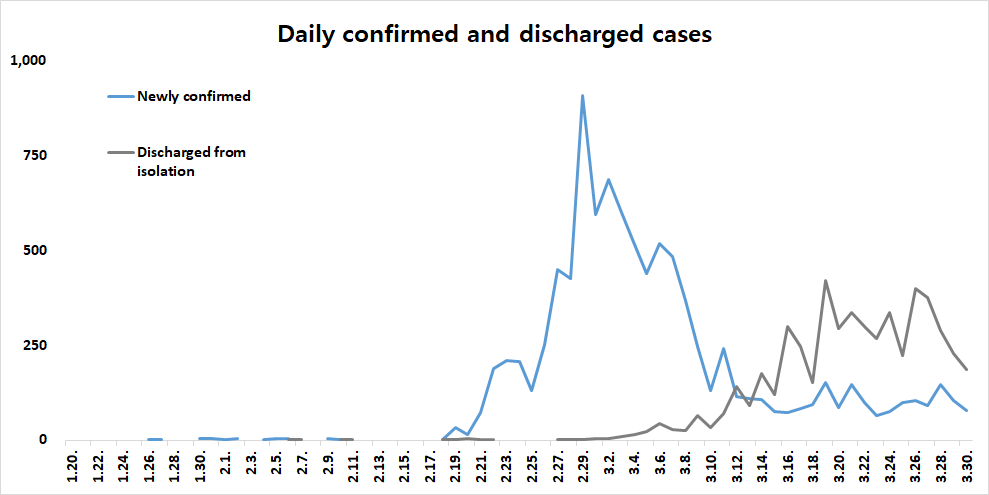
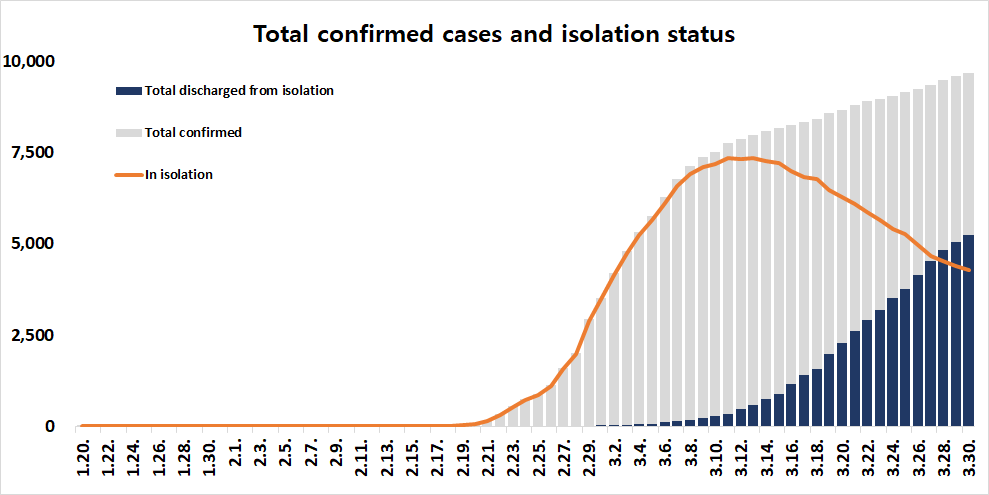
[Figure 3: Distribution of confirmed cases based on location reported]
*Refer to attachment
○ Case distribution data:
[Table 3: Confirmed cases by region]
|
|
Total |
City |
||||||||||||||||
|
Seoul |
Busan |
Daegu |
Incheon |
Gwangju |
Daejeon |
Ulsan |
Sejong |
|||||||||||
|
Isolated |
4,275 |
334 |
28 |
2,676 |
43 |
7 |
17 |
20 |
34 |
|||||||||
|
Discharged |
5,228 |
92 |
87 |
3,837 |
15 |
13 |
17 |
19 |
12 |
|||||||||
|
Deceased |
158 |
0 |
3 |
111 |
0 |
0 |
0 |
0 |
0 |
|||||||||
|
Subtotal |
9,661 |
426 |
118 |
6,624 |
58 |
20 |
34 |
39 |
46 |
|||||||||
|
(Change) |
(78) |
(16) |
(1) |
(14) |
- |
- |
- |
- |
- |
|||||||||
|
|
Province |
Other |
||||||||||||||||
|
Gyeonggi |
Gangwon |
Chung-buk |
Chung- nam |
Jeon- buk |
Jeon- nam |
Gyeong- buk |
Gyeong-nam |
Jeju |
Airport screening |
|||||||||
|
Isolated |
298 |
14 |
23 |
44 |
6 |
6 |
488 |
30 |
5 |
202 |
||||||||
|
Discharged |
160 |
21 |
21 |
83 |
7 |
3 |
772 |
65 |
4 |
0 |
||||||||
|
Deceased |
5 |
1 |
0 |
0 |
0 |
0 |
38 |
0 |
0 |
0 |
||||||||
|
Subtotal |
463 |
36 |
44 |
127 |
13 |
9 |
1,298 |
95 |
9 |
202 |
||||||||
|
(Change) |
(15) |
(2) |
(3) |
- |
(1) |
- |
(11) |
(1) |
(1) |
(13) |
||||||||
|
|
||||||||||||||||||
[Table 4: Case distribution and incidence rate by region]
|
Region |
# of cases |
(%) |
Incidence rate (per 0.1M) |
Region |
# of cases |
(%) |
Incidence rate (per 0.1M) |
|
Seoul |
426 |
(4.41) |
4.38 |
Gyeonggi |
463 |
(4.79) |
3.49 |
|
Busan |
118 |
(1.22) |
3.46 |
Gangwon |
36 |
(0.37) |
2.34 |
|
Daegu |
6,624 |
(68.56) |
271.87 |
Chungbuk |
44 |
(0.46) |
2.75 |
|
Incheon |
58 |
(0.60) |
1.96 |
Chungnam |
127 |
(1.31) |
5.98 |
|
Gwangju |
20 |
(0.21) |
1.37 |
Jeonbuk |
13 |
(0.13) |
0.72 |
|
Daejeon |
34 |
(0.35) |
2.31 |
Jeonnam |
9 |
(0.09) |
0.48 |
|
Ulsan |
39 |
(0.40) |
3.40 |
Gyeongbuk |
1,298 |
(13.44) |
48.75 |
|
Sejong |
46 |
(0.48) |
13.44 |
Gyeongnam |
95 |
(0.98) |
2.83 |
|
Airport Screening |
202 |
(2.09) |
- |
Jeju |
9 |
(0.09) |
1.34 |
|
|
|
|
|
Total |
9,661 |
(100) |
18.63 |
[Figures 4-7: Daily case trends by region (Daegu, Gyeongbuk, Seoul, Gyeonggi)]
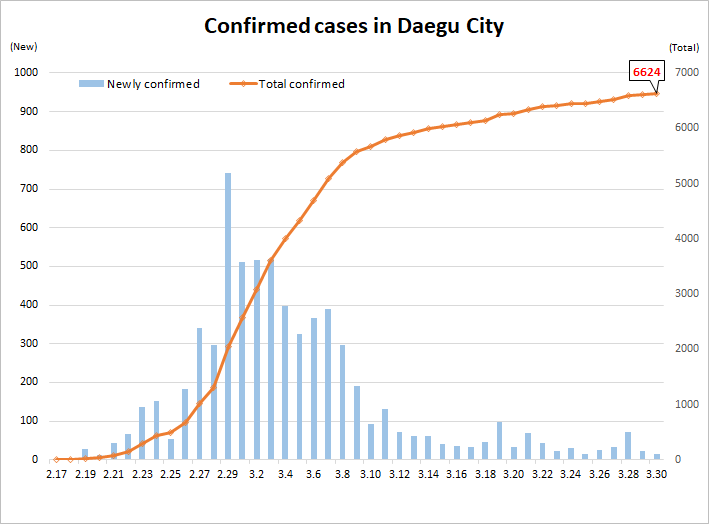
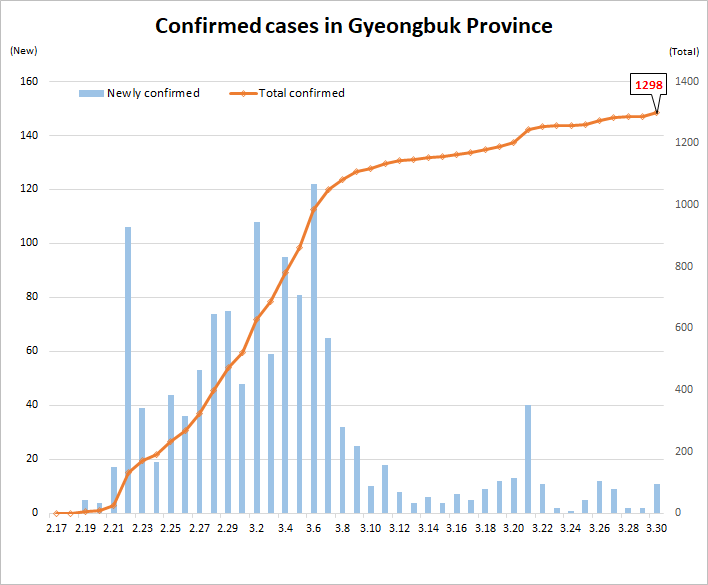
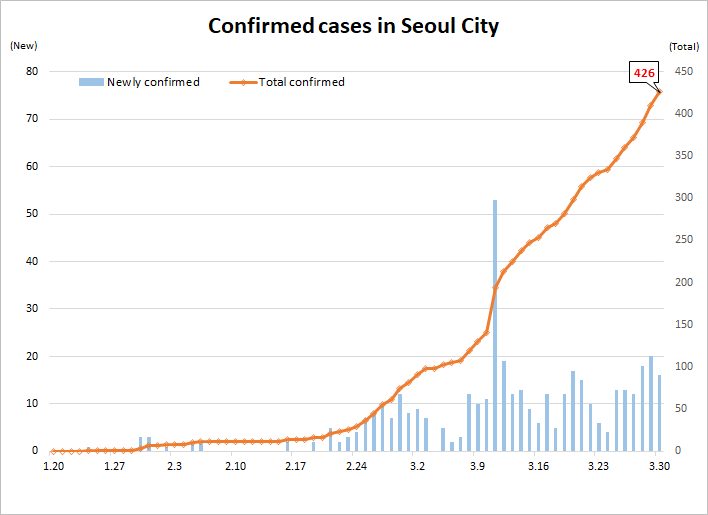
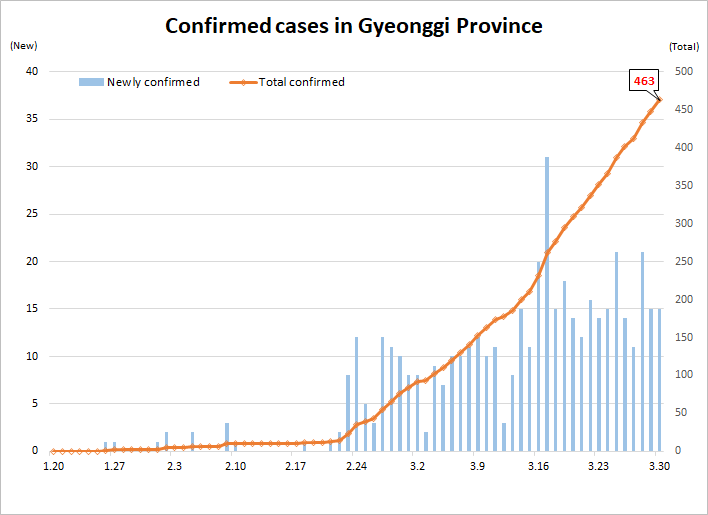
[Table 5: Case distribution by gender and age group]
|
|
Confirmed Cases |
(%) |
Deaths |
(%) |
Fatality rate (%) |
|
|
Total |
9,661 |
(100) |
158 |
(100) |
1.64 |
|
|
Sex |
Male |
3,834 |
(39.69) |
80 |
(50.63) |
2.09 |
|
Female |
5,827 |
(60.31) |
78 |
(49.37) |
1.34 |
|
|
Age |
80 and above |
437 |
(4.52) |
80 |
(50.63) |
18.31 |
|
70-79 |
640 |
(6.62) |
45 |
(28.48) |
7.03 |
|
|
60-69 |
1,218 |
(12.61) |
21 |
(13.29) |
1.72 |
|
|
50-59 |
1,812 |
(18.76) |
10 |
(6.33) |
0.55 |
|
|
40-49 |
1,297 |
(13.43) |
1 |
(0.63) |
0.08 |
|
|
30-39 |
1,002 |
(10.37) |
1 |
(0.63) |
0.10 |
|
|
20-29 |
2,630 |
(27.22) |
0 |
(0.00) |
- |
|
|
10-19 |
513 |
(5.31) |
0 |
(0.00) |
- |
|
|
0-9 |
112 |
(1.16) |
0 |
(0.00) |
- |
|
[Figures 8-9: Case distribution by gender and age group]
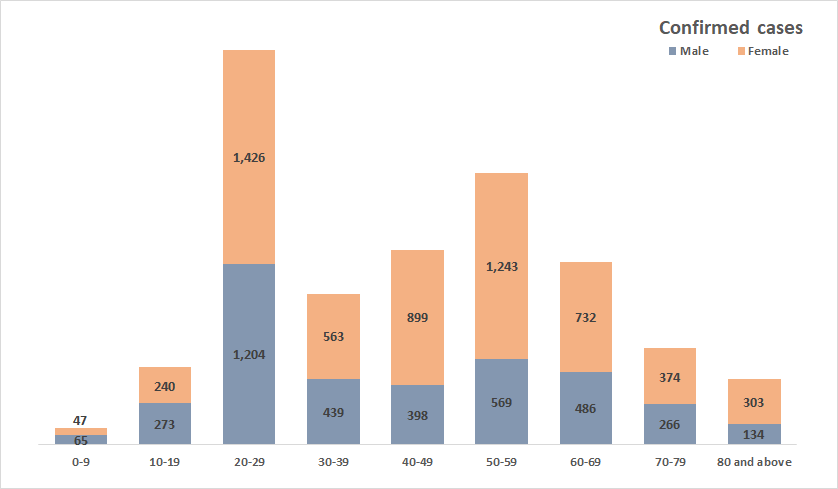
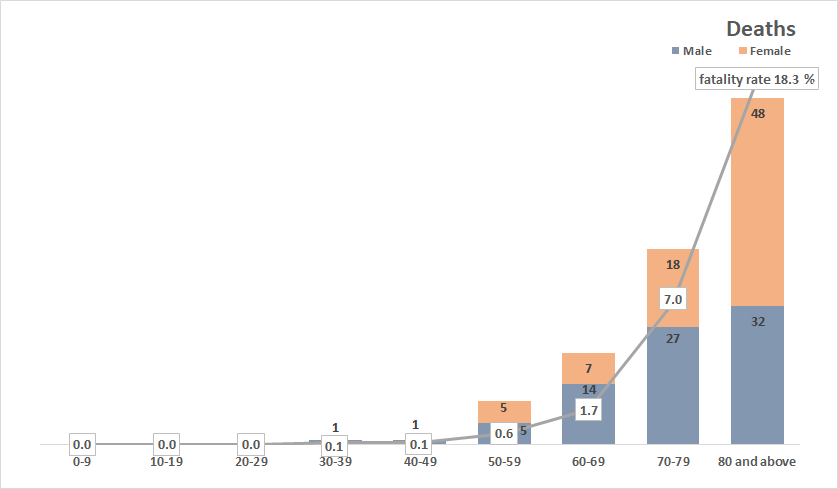
[Table 6: Age distribution of severe cases]
|
Age group |
Total |
Severe |
( |
% |
) |
Very severe |
( |
% |
) |
|
Total |
74 |
22 |
( |
100.0 |
) |
52 |
( |
100.0 |
) |
|
80 and above |
13 |
8 |
( |
36.4 |
) |
5 |
( |
9.6 |
) |
|
70-79 |
28 |
6 |
( |
27.3 |
) |
22 |
( |
42.3 |
) |
|
60-69 |
22 |
5 |
( |
22.7 |
) |
17 |
( |
32.7 |
) |
|
50-59 |
6 |
1 |
( |
4.5 |
) |
5 |
( |
9.6 |
) |
|
40-49 |
4 |
2 |
( |
9.1 |
) |
2 |
( |
3.8 |
) |
|
30-39 |
0 |
0 |
( |
0.0 |
) |
0 |
( |
0.0 |
) |
|
20-29 |
1 |
0 |
( |
0.0 |
) |
1 |
( |
1.9 |
) |
|
10-19 |
0 |
0 |
( |
0.0 |
) |
0 |
( |
0.0 |
) |
|
0-9 |
0 |
0 |
( |
0.0 |
) |
0 |
( |
0.0 |
) |
[Figure 10: Incidence rate by age group (per 100,000)]
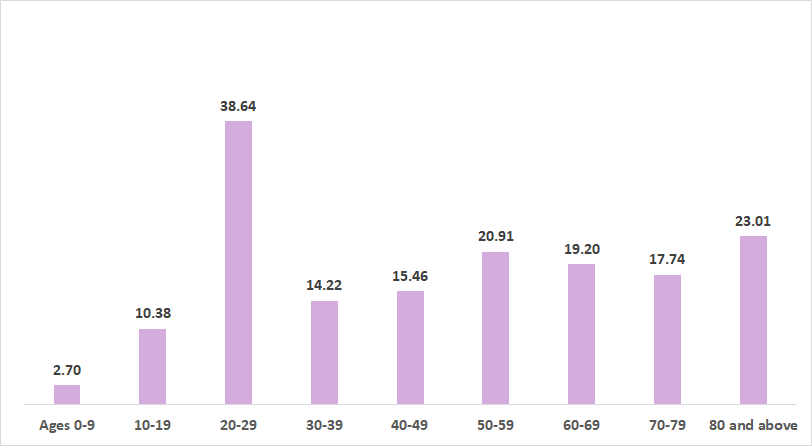
[Figure 11: Weekly trend of imported cases]

 This public work may be used under the terms of the public interest source + commercial use prohibition + nonrepudiation conditions
This public work may be used under the terms of the public interest source + commercial use prohibition + nonrepudiation conditions